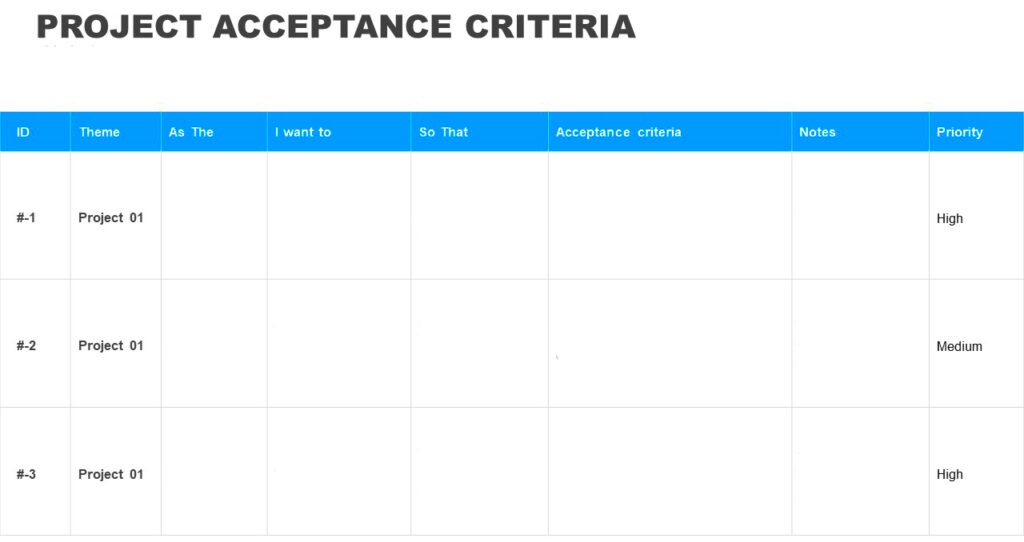Acceptance criteria play a crucial role in the landscape of project management, serving as a foundational component that guides the delivery and evaluation of project outputs. The use of an acceptance criteria template can significantly enhance the clarity and efficiency of this process.
Thank you for reading this post, don't forget to subscribe!This article explores the essential aspects of acceptance criteria within the context of project management, particularly focusing on its pivotal role during project initiation.
Understanding Acceptance Criteria In Project
Acceptance criteria consist of conditions that a project must meet to be accepted by the client, stakeholders, or project management team. These criteria are instrumental in defining the functional and non-functional requirements that determine the success of project deliverables.
Essentially, they set the standard for what is deemed acceptable, ensuring that the final product aligns with the initial project goals and customer needs.
The Role of Acceptance Criteria Template in Project Initiation
An acceptance criteria template serves as a pre-defined structure that project teams can use to ensure consistency and completeness in defining what needs to be accomplished. This Doc helps streamline the process of establishing acceptance criteria and ensure that all project members have a clear understanding of the objectives from the outset.
Components of an Effective Acceptance Criteria Template
Here are some core components that must be included in this document;

Project Overview
This section provides a brief description of the project, including its scope and objectives. It sets the stage for detailing specific requirements that the project outcomes must fulfill.
Criteria Details
This is the core of the template where specific acceptance criteria are listed. Each criterion should be clear, concise, and measurable. Criteria might include performance metrics, compliance standards, functionality, and usability requirements.
Validation Methods
For each set of criteria, the template should specify how compliance with these criteria will be verified. This might include tests, demonstrations, or reviews that will be used to confirm that the deliverables meet the stated standards.
Stakeholder Approval
This section identifies who is responsible for approving the deliverables based on the acceptance criteria. It may list project managers, clients, or other stakeholders involved in the approval process.
Strategic Importance in Project Initiation
During project initiation, acceptance criteria templates are particularly valuable. They provide a clear, shared understanding of what the project aims to achieve, which helps in aligning the expectations of stakeholders and the project team.
Setting Clear Expectations
Right from the start, acceptance criteria establish clear boundaries and definitions for project deliverables. This clarity helps prevent scope creep and ensures that all team members understand what is expected.
Enhancing Stakeholder Engagement
By involving stakeholders in the development and approval of acceptance criteria, a template ensures that their expectations are accurately captured and addressed. This engagement is crucial for securing stakeholder support and for the successful delivery of the project.
Facilitating in Early Risk Identification
Clear acceptance criteria help identify potential risks at the beginning of the project. Understanding what must be achieved makes it easier to spot where things could go wrong, allowing for proactive risk management.
Improving Quality Control
By defining how and when project outputs will be evaluated, acceptance criteria templates contribute to ongoing quality control throughout the project lifecycle. This structured approach to quality ensures that deliverables consistently meet the required standards.
Best Practices for Implementing Acceptance Criteria Document
These 4 best practices are highly recommended to draft this document in a effective way;
Involve Key Stakeholders
Engage all relevant stakeholders in the process of defining acceptance criteria to ensure their needs and expectations are thoroughly considered and integrated.
Keep Criteria Measurable and Testable
To avoid ambiguity, ensure that each criterion can be quantified or qualitatively assessed in a clear, objective manner.
Review and Update Regularly
Acceptance criteria should not be static. As projects progress and new information emerges, it may be necessary to revise the criteria to reflect changes in scope or objectives.
Integrate with Project Management Toolkit
Embedding the acceptance criteria template into project management toolkit can help maintain visibility and trackability, ensuring that all team members are up-to-date with the criteria and their statuses.
Conclusion
Acceptance criteria templates are vital tools in project management, particularly during the initiation phase. They establish a clear roadmap for project success by setting precise standards for deliverables, enhancing stakeholder engagement, and facilitating effective risk management.
By adopting a systematic approach to developing and implementing PID Document, organizations can improve project outcomes, reduce misunderstandings, and ensure that final products meet or exceed stakeholder expectations.
This strategic utilization of acceptance criteria doc ultimately supports the achievement of project goals and enhances the overall effectiveness of project management practices.




